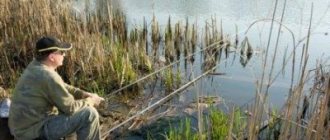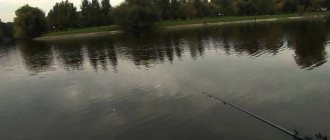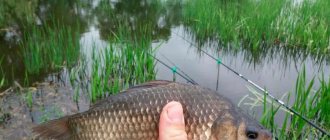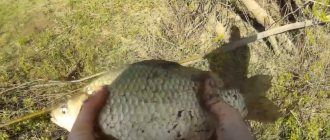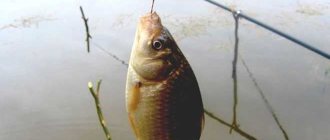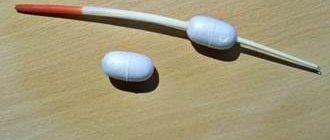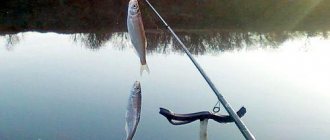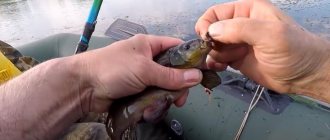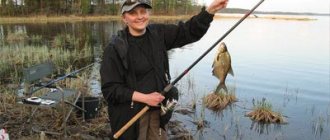Behavior of crucian carp in August
The advantage of catching crucian carp at the end of summer is that at this time the crucian carp begins to actively feed and gain fat. It’s as if he knows that in the fall all the vegetation and microorganisms of the reservoir will cease their vital activity, and he tries to eat his fill in order to calmly lie down for winter hibernation. This is especially noticeable in the last weeks of August.
The fish takes the bait much more decisively and generally feels comfortable in cooler water, and, therefore, becomes less cautious. It is interesting that it is during this period that the fish, taking the bait, takes it sharply to the side or drags it to the bottom, which is completely uncharacteristic when fishing in other periods.
The behavior of crucian carp in August largely depends on the climatic conditions of a particular region. The further north the reservoir in which the fish lives is located, the earlier it begins to look for places to hibernate, burrowing into the silt, which can be observed even in the second ten days of August. In this case, the crucian carp completely stops feeding, and, therefore, there is no chance of catching it. In the southern regions, fish sometimes remain active even at the beginning of September.
Bottom gear
The most commonly used donkeys for catching crucian carp in August are:
- Donka-zakidushka is the simplest tackle, which consists of a reel with fishing line, a sinker and leashes with hooks.
- A simple donka - consists of a rod with guides, a reel and equipment, at the end of which there is a sinker and one or more leashes with hooks.
Good results in August can be achieved by catching crucian carp using a nipple - a folk tackle with a feeder in which hooks are hidden . In a feeder, a similar installation is called method installation.
Donka is a good choice for catching crucian carp away from the shore , where you can always find large fish. Although in August, trophy specimens often approach the water’s edge in search of food.
[custom_ads_shortcode3]
Best time for fishing
It is important to know when crucian carp become most active in search of food. As practice shows, the best catch can be achieved if you go fishing at 5 o’clock in the morning. The bite will continue for 4–5 hours, after which it will gradually begin to subside. This applies to the beginning of the month. In the last weeks of August, the fish, on the contrary, switch to daytime mode.
Important! A harbinger of a good catch is a light, warm morning rain.
Now you don’t have to deny yourself the pleasure of sleep, since the gear can be set up from 9 o’clock in the morning. In this case, fishing will be productive until 5 pm. In the last week of August, small fish stop biting, and mostly large specimens are caught on the hook.
What weather should you fish in?
For successful fishing, the fisherman should not only know the weather forecast for the time of fishing, but also analyze climate changes over the past few days. This will make it possible to get a general picture of the changes and, accordingly, estimate how active the bite will be. For example, at the beginning of August you can often experience quite hot weather. Crucian carp, although thermophilic, cannot tolerate extreme heat, so it goes deeper, which negatively affects the bite. At the end of the month the situation changes - cool days and nights activate the fish.
In addition to air temperature, atmospheric pressure also influences the bite. Its high level has a bad effect on crucian carp. At depth, water acquires increased density, and its upper layers contain less oxygen. At this time, the crucian carp simply freezes at depth, and all its vital processes are suspended. A sharp drop in pressure affects the behavior of the fish even worse - it can even lose orientation. The most favorable periods are considered to be periods when the pressure remains stably at the same level for several days, as well as days when it slowly decreases.
In August, the optimal level of atmospheric pressure should be around 745–752 mm Hg. Art., but if it is even a little lower, but stably stays at the same level, this also contributes to the bite. It should also be taken into account that during strong gusty or stormy winds, crucian carp practically do not feed. And fishing is quite difficult, since the wind forces the bait to move unnaturally, which scares the fish, and it is almost impossible to determine the bite.
Preparing gear for catching crucian carp
A variety of gear is suitable for catching crucian carp. True, float rods are used much less frequently. During this period, bottom equipment is more often used, on which fish bite more productively, gradually going into the depths.
Find out also about the features of catching crucian carp using corn.
Float rod
If you are a fan of fishing with a float rod, choose the option that is most suitable for the conditions of the reservoir. Any type can be used. For example, the most popular is the fly rod, but it is suitable for close-range fishing. If you plan to fish with long casting, which is more effective for fishing in August, it is better to take a match rod.
For fast-flowing river conditions, fishermen use a Bolognese fishing rod. To make fishing more effective, it is recommended to put two hooks with plant and animal bait on the tackle at once. Crucian carp will bite mostly on a worm or bloodworm, but the presence of, for example, pearl barley or mastyrka nearby will improve the bite.
Bottom gear
Bottom gear is best suited for catching crucian carp in August, away from the shore. Using them, you can return home with a good trophy.
These include:
- Ordinary donka. This is the simplest gear in design. It consists of a reel, fishing line, leashes with hooks and weight.
- Donka-zakidushka. A more complicated option. It contains a rod with guides and a reel, from which comes a fishing line with a sinker and leaders.
- Rubber. This is an improved version, the design of which, in addition to fishing line with leashes, includes an elastic band. This allows you to constantly place the equipment in the same place in the reservoir.
- Feeder. The tackle is similar to a donka, but its main difference is the presence of a feeder, which also serves as a sinker.
When fishing on a feeder with long casting, it is better to use special feeders made in the shape of a shuttlecock. Their flight range is 30% greater than that of conventional ones.
Crucian carp in July
In July, the fish are no longer hungry, and they begin to react even more sharply to changing weather and heat. The worst way to catch crucian carp is in still water on a windless day, as the amount of dissolved oxygen in it drops.
When the temperature rises to 30 degrees, it goes deeper away from the shore. Therefore, a fly-float fishing rod is not always the best option, and long-casting gear should be chosen.
For fishing in July, it is better to choose cloudy days and times when there is light rain. Sometimes in a thunderstorm you can get some really great catches. Crucian carp can also be caught well in shady places - under bridges, in the shade of trees and buildings.
Fishing for crucian carp in July can be very successful in cool weather and in reservoirs where the water is cooled by springs gushing from underground.
What does it bite on?
The best bait for crucian carp is considered to be a dung worm, which awakens a genuine appetite in the fish, as a result of which bites can be observed after each cast. Moreover, this attachment turns out to be effective both in river conditions and in lakes and ponds. An alternative is maggot, but this bait is not effective in all bodies of water. Its attractiveness largely depends on the natural fauna; it is most often used when fishing in lakes with stagnant water.
Did you know? Crucian carp really love the smell of garlic. Anglers use this to create a primitive but effective bait: they rub garlic on rocks and throw them into the fishing spot.
Another “tasty” option is bloodworms or beetle larvae. Animal baits are very effective in August, since during this period crucian carp are looking for food rich in protein. Even raw and boiled meat, cut into small pieces, will become a real treat for fish. Of the baits of plant origin, the most attractive for crucian carp are semolina, dough, canned corn, pearl barley, mastyrka, and bread. They are especially indispensable when fishing in the first half of August, when the water is still quite warm. Fish bite on pearl barley, corn and dough more often in the evening.
If you are going to fish with a float rod with two hooks, you can use different baits, for example, string a ball of bread on one, and a worm on the second. Small baits can be put on 2-3 pieces on one hook, making a kind of delicious “sandwiches”.
Catching crucian carp with a float. How to catch?
Experience shows that fishing for crucian carp with a float is best suited for fishing in autumn and early spring.
Of course, provided that the angler is extremely accurate and has good reaction and coordination of movements. At first, it is important to determine the place where crucian carp are likely to accumulate by making several casts.
By the middle of summer, when the weather is hot, crucian carp practically does not bite from the bottom, and, perhaps, few people have tried to catch it with a slight descent from the top, but in vain.
This kind of fishing requires light tackle with a distributed load. This is necessary so that the bait sinks into the water as naturally as possible, since loud slaps from heavy tackle can simply frighten the fish. Typically, the depth is set to 1 meter.
Each time you cast the tackle, you need to feed the fish with a small portion of bait. After the float has assumed a vertical position, you should begin to perform short, smooth pulls on the tackle with short stops.
The same technique is used when fishing from the bottom. In this case, a baited “path” leading to the shore is first created.
The bites of crucian carp are quite varied and directly depend on many external factors: time of day, season, fish density, etc.
For example, in the spring the bite of hungry fish is sharp and rapid. In summer and autumn, when there is plenty of food, crucian carp take bait with caution. This is noticeable on the float due to its light pressure and lift.
If the nozzle is compact, then when the float moves noticeably, a soft hook should be made. Crucian carp have rather weak lips, so you shouldn’t force it to catch it, especially for large specimens.
Fishing for crucian carp: the best baits and baits. Issue No. 60 (video)
The best bait
Of course, any fishing begins with high-quality bait. Today you can buy a variety of ready-made mixtures in stores. But experienced fishermen more often use proven compositions made with their own hands. For example, one of the best baits is considered to be a mixture of sunflower cake, cookies, breadcrumbs, bloodworms and maggots. Animal filler should be no more than 10%. Vanillin, dill seeds or honey are added as flavoring agents, and clay acts as a binding component.
All ingredients must be thoroughly mixed until smooth. If you are going to catch crucian carp on a river with a current, it is better to place the mixture in a gauze bag. Another way to make good bait for crucian carp is to mix dough, the pulp of fresh rye bread and bloodworms. You can “season” the composition with sunflower oil or valerian.
Experienced fishermen sometimes prepare special bait - porridge with a rather complex composition. Although the process of preparing it is not so simple, it often turns out to be the most attractive for crucian carp.
Read also how to prepare pearl barley for fishing in a thermos.
It is done as follows:
- Add 100 g of millet to 300 ml of water and boil for 15 minutes. After boiling, add 1 tbsp. l. vegetable oil (preferably homemade) and 1/3 tsp. honey, mix.
- Pour 200 g of barley or corn grits into a separate bowl, add boiled millet and mix. Leave overnight for swelling.
- Immediately before fishing, add enough breadcrumbs so that the gruel acquires a thick consistency.
Lures for August fishing
Successful fishing for crucian carp begins with high-quality bait. Each experienced fisherman has his own secrets for making the mixture. Here are some proven compositions: First: • Store-bought bait for carp fish.
• Small food bloodworms (larvae of the long-running mosquito). • Maggot.
If the crucian carp does not take bait, you can add honey or vanilla sugar to it.
Second: • Hemp or sunflower cake. • Cookie. • Breadcrumbs.
• Bloodworm. • Maggot. Without this larva, catching crucian carp in August is almost impossible.
• Clay. • A little vanillin, or mashed dill seeds, or a couple of mashed green garlic arrows. Everything is thoroughly mixed.
If the reservoir has a current, the bait should be thrown into the water, tied in gauze. Third: • Dough. • Crumb of fresh rye bread.
• Bloodworm. Mix everything and roll the mixture into balls. Season with hemp, mint or anise oil.
Bloodworms and maggots in any composition should be no more than 10%. The crucian carp quickly gets used to this treat, going to the same place to feed every morning. In addition, you can bait the fish with steamed wheat, boiled corn, peas, and butter bread crumbs. All products must be fresh. It is important not to overfeed future prey - a well-fed crucian carp is reluctant to take bait. In this case, fishermen use the following trick: they rub the stones with garlic and throw them into the water. The fish, attracted by the strong smell, begins to actively grab the bait. It has been noticed that crucian carp reacts quickly to changes in complementary foods, so there is no need to be afraid to experiment. Crucian carp is a voracious and omnivorous fish, so you can use both animal and plant baits on the hook: • Red dung worms (the best option). • Maggots. • Bloodworm. • Burdock moth larvae. To ensure that the larvae stay on the hook better, they are first placed in a gauze bag and dipped in boiling water. • Small grasshoppers and large flies. • Raw and cooked meat, cut into squares. • Fresh bread crumbs, pancakes. • Boiled pasta, pearl barley, semolina.
If fishing is sluggish, you can try to make a “sandwich” for crucian carp - attach two bloodworms with a maggot in the middle. This combination also attracts the attention of the fish: a small worm, a maggot and a larger worm at the bottom. Alternating plant and animal bait gives good results.
[custom_ads_shortcode3]
Reasons for lack of bite
Since August is a rather difficult month for crucian carp, characterized by changes in weather, pressure and other indicators, it may well happen that you return from fishing with nothing.
Did you know? There is an opinion that the bite of crucian carp largely depends on what phase the Moon is in. The most successful fishing will be during the waning moon and on the new moon.
The reasons for this can be varied, namely:
- increased atmospheric pressure or its sudden changes;
- incorrect choice of nozzle that is not suitable for the conditions of the reservoir;
- strong wind;
- excessively hot days in the first half of August or very cold days in the second;
- an inappropriate place, for example, fishing in reed thickets at the end of summer will not bring anything good.
It should also be taken into account that the bite during the day is greatly influenced by the presence of other representatives of aquatic fauna in the reservoir. For example, if there is a pike in the river, the crucian carp will go out to feed exclusively at night, when it practically does not notice its proximity to the predator.
Inexperienced fishermen often think that crucian carp is a capricious fish. Actually this is not true. If you choose the right gear, bait and determine a good place, catching it will not be difficult. In addition, the process will bring a lot of pleasure, especially if you fish with hand-made equipment.
